This is the third blog post in a four-part series. Read Part 1 | Part 2 | Part 4.
In Part 1 of this four-part blog series examining wiper malware, the CrowdStrike Endpoint Protection Content Research Team introduced the topic of wipers, reviewed their recent history and presented common adversary techniques that leverage wipers to destroy system data. In Part 2, the team dove into third-party drivers and how they may be used to destroy system data.
While the majority of the wiper families use a few IOCTLs, DriveSlayer makes use of an extensive list of IOCTLs to achieve its goals. Some IO control codes are used to acquire information about the disks of the infected machine like NTFS partition tables, move files, fingerprint the drive, etc.
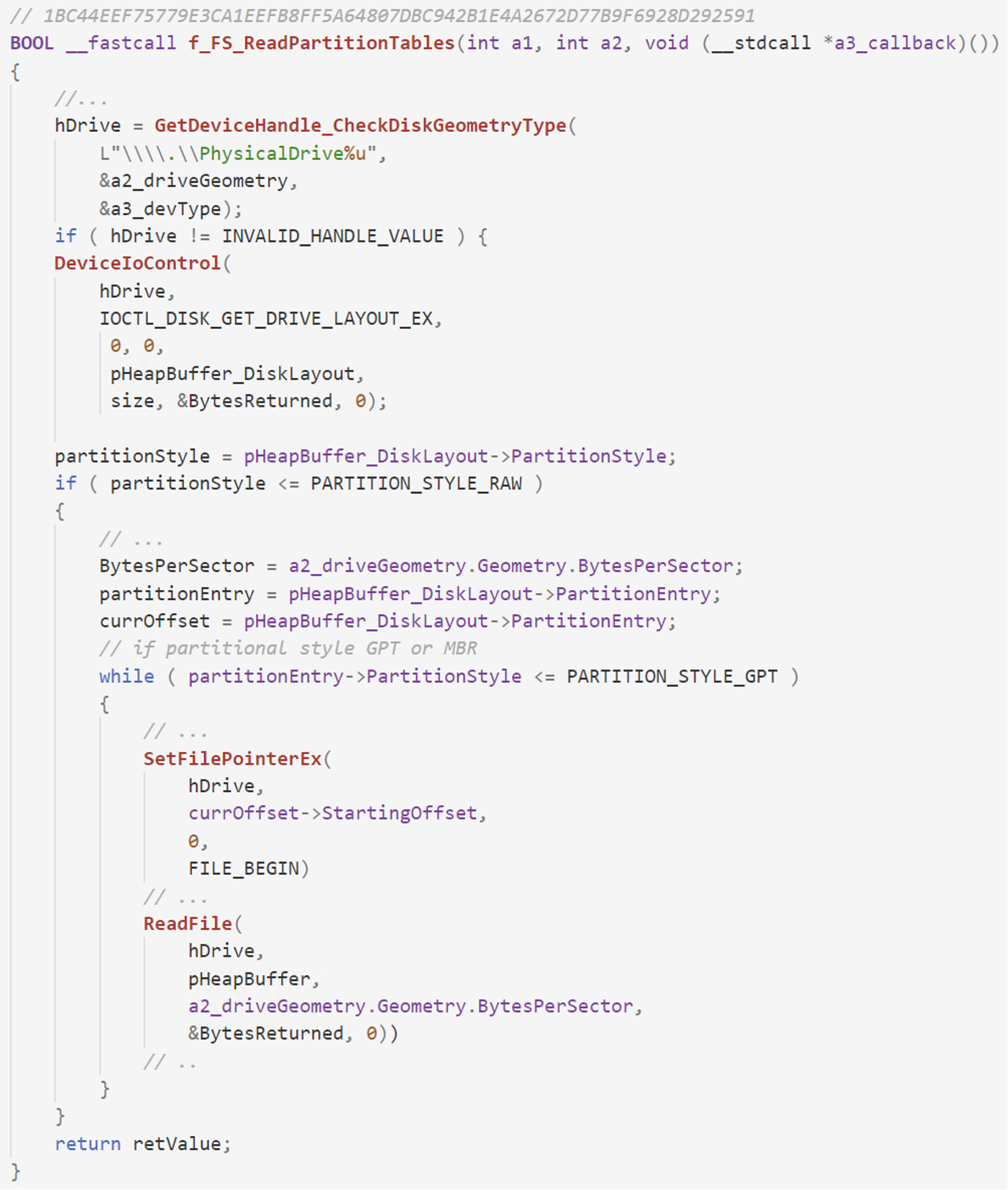 Figure 1. DriveSlayer acquires disk layout information via IOCTL_DISK_GET_DRIVE_LAYOUT_EX, followed by the usage of the returned data to determine which disk sectors to overwrite
DriveSlayer also uses IOCTL_STORAGE_GET_DEVICE_NUMBER to grab information such as partition number and device type, which is later used in the wiper process.
Figure 1. DriveSlayer acquires disk layout information via IOCTL_DISK_GET_DRIVE_LAYOUT_EX, followed by the usage of the returned data to determine which disk sectors to overwrite
DriveSlayer also uses IOCTL_STORAGE_GET_DEVICE_NUMBER to grab information such as partition number and device type, which is later used in the wiper process.
 Figure 2. Acquire various other info via the IOCTL_STORAGE_GET_DEVICE_NUMBER IOCTL
Figure 2. Acquire various other info via the IOCTL_STORAGE_GET_DEVICE_NUMBER IOCTL
 Figure 3. Acquire list of drives via the GetLogicalDriveStrings API and send it to the callback function to lock and dismount
The usage of FSCTL_LOCK_VOLUME and FSCTL_DISMOUNT_VOLUME IO control codes can be seen in the following function call.
Figure 3. Acquire list of drives via the GetLogicalDriveStrings API and send it to the callback function to lock and dismount
The usage of FSCTL_LOCK_VOLUME and FSCTL_DISMOUNT_VOLUME IO control codes can be seen in the following function call.
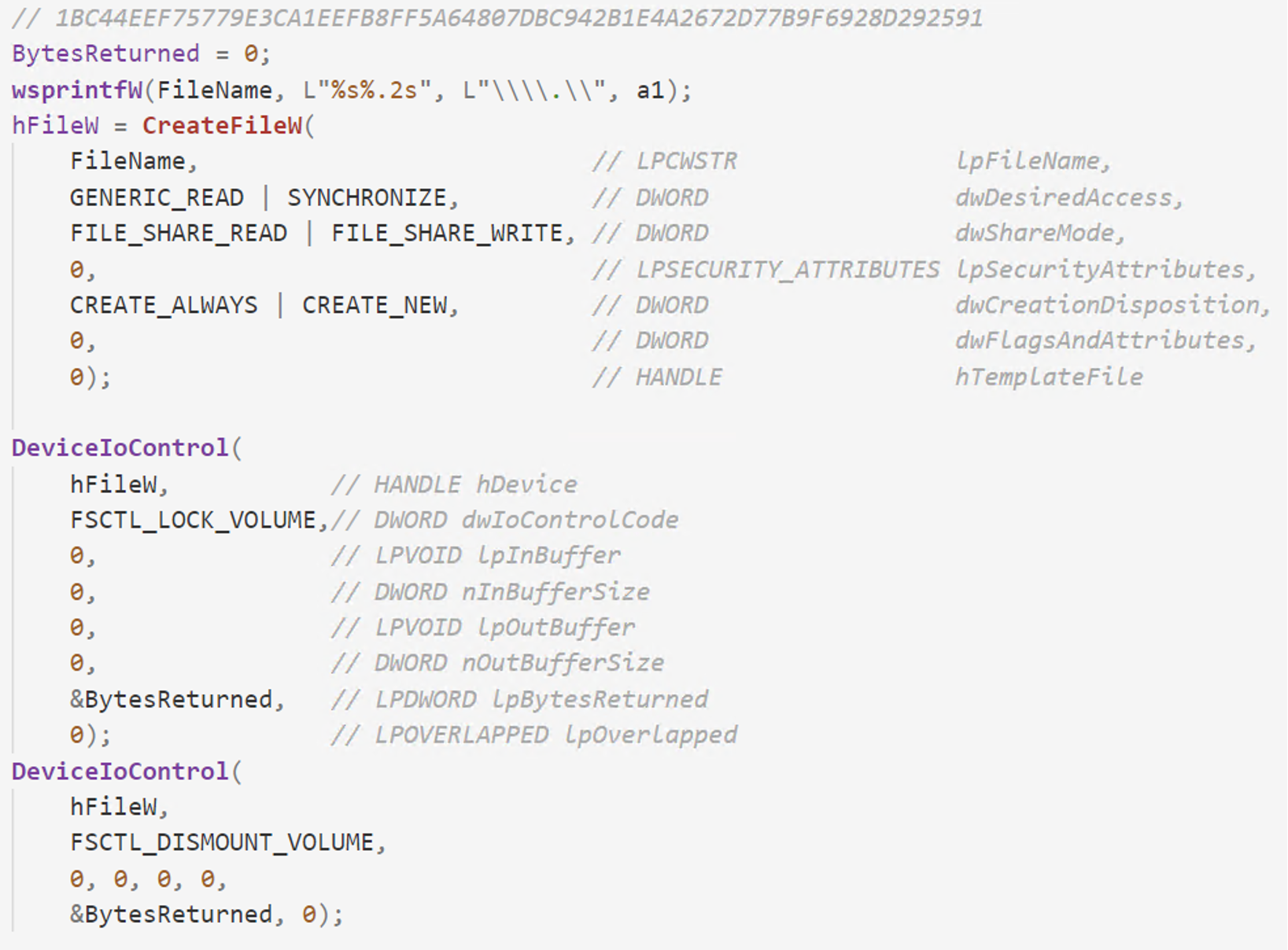 Figure 4. Usage of FSCTL_LOCK_VOLUME and FSCTL_DISMOUNT_VOLUME for locking and dismounting the volume
Figure 4. Usage of FSCTL_LOCK_VOLUME and FSCTL_DISMOUNT_VOLUME for locking and dismounting the volume
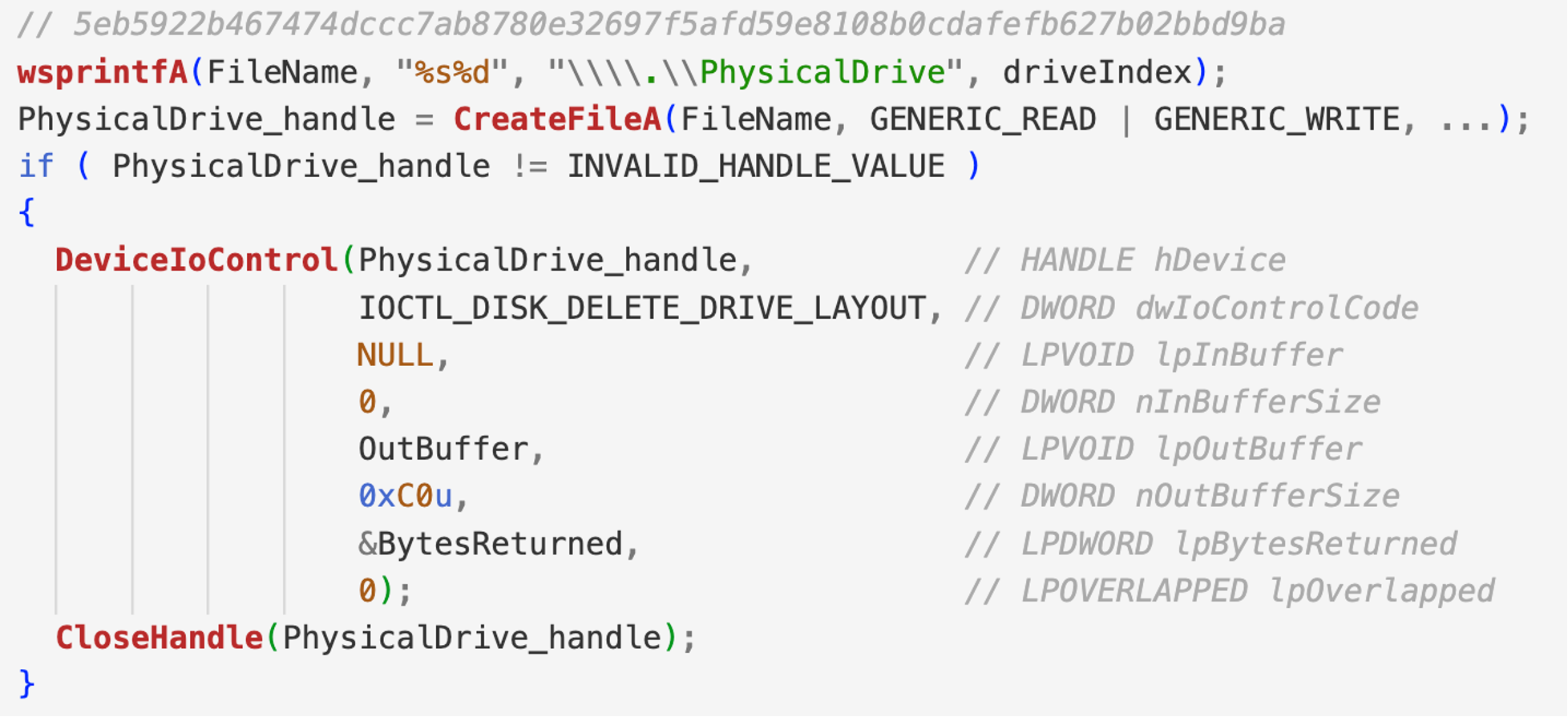 Figure 5. Usage of IOCTL_DISK_DELETE_DRIVE_LAYOUT that removes the boot signature from the master boot record, so that the disk will be formatted from sector zero to the end of the disk
Figure 5. Usage of IOCTL_DISK_DELETE_DRIVE_LAYOUT that removes the boot signature from the master boot record, so that the disk will be formatted from sector zero to the end of the disk
 Figure 6. Grab bitmap representation of cluster usage via FSCTL_GET_VOLUME_BITMAP
Figure 6. Grab bitmap representation of cluster usage via FSCTL_GET_VOLUME_BITMAP
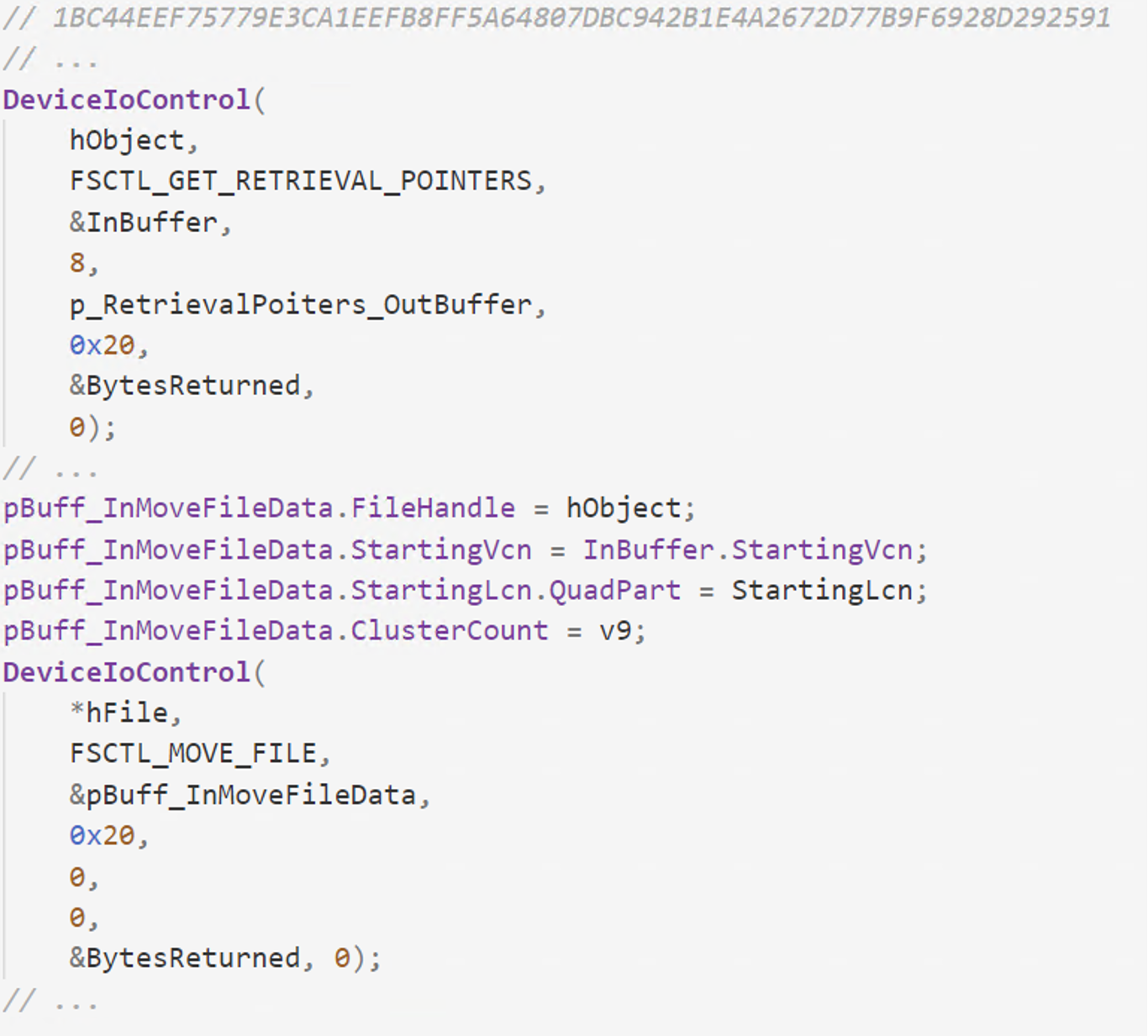 Figure 7. Fragmentation of data by using the FSCTL_MOVE_FILE IOCTL
Figure 7. Fragmentation of data by using the FSCTL_MOVE_FILE IOCTL
 Figure 8. Obtaining the reparse point data associated with the file or directory by using FSCTL_GET_REPARSE_POINT IOCTL, followed by checks for symlinks or mount points
Figure 8. Obtaining the reparse point data associated with the file or directory by using FSCTL_GET_REPARSE_POINT IOCTL, followed by checks for symlinks or mount points
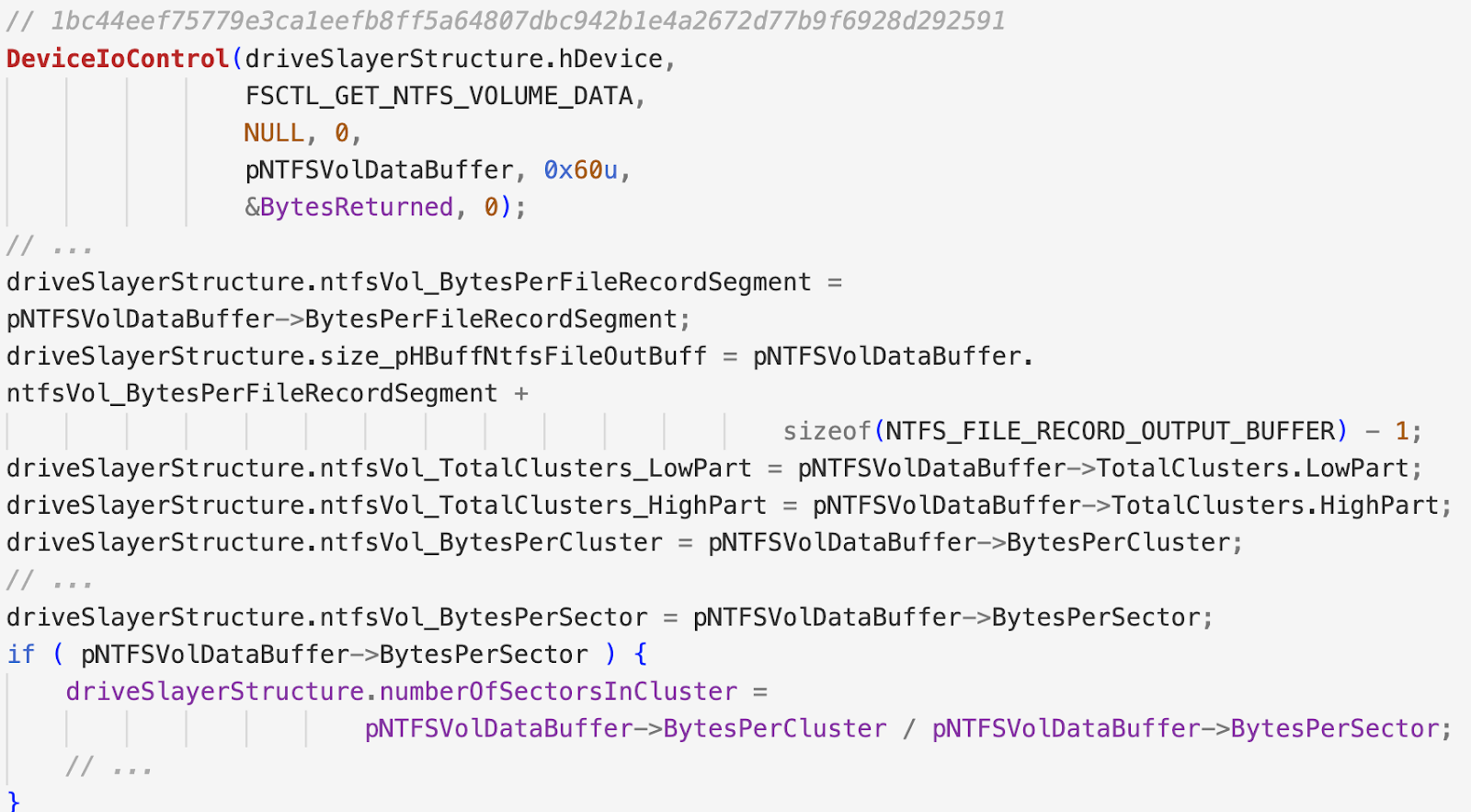 Figure 9. Gather volume data via the FSCTL_GET_NTFS_VOLUME_DATA IOCTL
The FSCTL_GET_NTFS_FILE_RECORD IOCTL is used to enumerate files from a NTFS formatted drive. The information is returned inside the NTFS_FILE_RECORD_OUTPUT_BUFFER structure that is sent as an argument to the DeviceIoControl API. Wipers like DriveSlayer use this IOCTL in order to determine the raw sectors associated with files and queue them for the wiping routine.
Figure 9. Gather volume data via the FSCTL_GET_NTFS_VOLUME_DATA IOCTL
The FSCTL_GET_NTFS_FILE_RECORD IOCTL is used to enumerate files from a NTFS formatted drive. The information is returned inside the NTFS_FILE_RECORD_OUTPUT_BUFFER structure that is sent as an argument to the DeviceIoControl API. Wipers like DriveSlayer use this IOCTL in order to determine the raw sectors associated with files and queue them for the wiping routine.
 Figure 10. Retrieve file record information via the FSCTL_GET_NTFS_FILE_RECORD IOCTL
Figure 10. Retrieve file record information via the FSCTL_GET_NTFS_FILE_RECORD IOCTL
 Figure 11. Falcon UI screenshot showcasing how wipers are detected by the Falcon agent
Figure 11. Falcon UI screenshot showcasing how wipers are detected by the Falcon agent
 Figure 12. Falcon UI screenshot showcasing detection of Petya by the Falcon sensor
Figure 12. Falcon UI screenshot showcasing detection of Petya by the Falcon sensor
In Part 3, we cover various input/output controls (IOCTLs) in more detail and how they are used to achieve different goals — including acquiring information about infected machines and locking/unlocking disk volumes, among others.
Input/Output Control (IOCTL) Primer
Throughout our analysis, we encountered different uses of IOCTLs across samples. These are used to obtain information about volumes or disks, as well as to achieve other functionalities like locking, unlocking, unmounting a volume, fragmentation of data on disk, and others. The analyzed samples use the following IOCTLs:| IOCTLs | IOCTL Constant Name | Used By |
| 0x00070000 | IOCTL_DISK_GET_DRIVE_GEOMETRY | Petya wiper variant, Dustman and ZeroCleare |
| 0x000700A0 | IOCTL_DISK_GET_DRIVE_GEOMETRY_EX | DriveSlayer, Dustman and ZeroCleare, IsaacWiper |
| 0x00070048 | IOCTL_DISK_GET_PARTITION_INFO_EX | Shamoon 2, Petya wiper variant |
| 0x00070050 | IOCTL_DISK_GET_DRIVE_LAYOUT_EX | DriveSlayer |
| 0x0007405C | IOCTL_DISK_GET_LENGTH_INFO | StoneDrill, Dustman and ZeroCleare |
| 0x0007C054 | IOCTL_DISK_SET_DRIVE_LAYOUT_EX | CaddyWiper |
| 0x0007C100 | IOCTL_DISK_DELETE_DRIVE_LAYOUT | SQLShred |
| 0x00090018 | FSCTL_LOCK_VOLUME | DriveSlayer, StoneDrill, IsaacWiper |
| 0x0009001C | FSCTL_UNLOCK_VOLUME | IsaacWiper |
| 0x00090020 | FSCTL_DISMOUNT_VOLUME | DriveSlayer, Petya wiper variant, StoneDrill |
| 0x00090064 | FSCTL_GET_NTFS_VOLUME_DATA | DriveSlayer |
| 0x00090068 | FSCTL_GET_NTFS_FILE_RECORD | DriveSlayer |
| 0x0009006F | FSCTL_GET_VOLUME_BITMAP | DriveSlayer |
| 0x00090073 | FSCTL_GET_RETRIEVAL_POINTERS | DriveSlayer, Shamoon 2 |
| 0x00090074 | FSCTL_MOVE_FILE | DriveSlayer |
| 0x000900A8 | FSCTL_GET_REPARSE_POINT | SQLShred |
| 0x000980C8 | FCSTL_SET_ZERO_DATA | DoubleZero |
| 0x002D1080 | IOCTL_STORAGE_GET_DEVICE_NUMBER | DriveSlayer, IsaacWiper |
| 0x00560000 | IOCTL_VOLUME_GET_VOLUME_DISK_EXTENTS | DriveSlayer, Petya wiper variant, SLQShred, Dustman and ZeroCleare |
Acquiring Information
In the example below, DriveSlayer is using the IOCTL_DISK_GET_DRIVE_LAYOUT_EX and IOCTL_DISK_GET_DRIVE_GEOMETRY_EX IOCTLs to obtain information about the partitions and geometry of a drive. This helps the wiper to determine the location of the MFTs and MBRs in order for them to be scheduled for wiping. Similar implementations can be found using the other IOCTLs in IsaacWiper, Petya wiper variant, Dustman or ZeroCleare. Figure 1. DriveSlayer acquires disk layout information via IOCTL_DISK_GET_DRIVE_LAYOUT_EX, followed by the usage of the returned data to determine which disk sectors to overwrite
Figure 1. DriveSlayer acquires disk layout information via IOCTL_DISK_GET_DRIVE_LAYOUT_EX, followed by the usage of the returned data to determine which disk sectors to overwrite Figure 2. Acquire various other info via the IOCTL_STORAGE_GET_DEVICE_NUMBER IOCTL
Figure 2. Acquire various other info via the IOCTL_STORAGE_GET_DEVICE_NUMBER IOCTLVolume Unmounting
The FSCTL_LOCK_VOLUME and FSCTL_DISMOUNT_VOLUME IOCTLs are used by DriveSlayer to lock and unmount a disk volume after the wiping routine has finished. In order to do so, DriveSlayer grabs a list of all the drive letters via GetLogicalDriveStrings, iterates through all of them, acquires a handle to each volume and sends two IOCTLs via DeviceIoControl API. A similar implementation is done by the Petya wiper variant and StoneDrill as well. Figure 3. Acquire list of drives via the GetLogicalDriveStrings API and send it to the callback function to lock and dismount
Figure 3. Acquire list of drives via the GetLogicalDriveStrings API and send it to the callback function to lock and dismount Figure 4. Usage of FSCTL_LOCK_VOLUME and FSCTL_DISMOUNT_VOLUME for locking and dismounting the volume
Figure 4. Usage of FSCTL_LOCK_VOLUME and FSCTL_DISMOUNT_VOLUME for locking and dismounting the volumeDestroying All Disk Contents
Besides the common approach of overwriting the MBR, SQLShred also calls the DeviceIoControl API with the IOCTL_DISK_DELETE_DRIVE_LAYOUT IO Control Code in order to make sure the disk is formatted from sector 0x00. Figure 5. Usage of IOCTL_DISK_DELETE_DRIVE_LAYOUT that removes the boot signature from the master boot record, so that the disk will be formatted from sector zero to the end of the disk
Figure 5. Usage of IOCTL_DISK_DELETE_DRIVE_LAYOUT that removes the boot signature from the master boot record, so that the disk will be formatted from sector zero to the end of the diskOverwriting Disk Clusters
The FSCTL_GET_VOLUME_BITMAP IOCTL is used by DriveSlayer to acquire a bitmap representation of the occupied clusters of a disk volume. The bitmap representation is returned as a data structure that describes the allocation state of each cluster in the file system, where positive bits indicate if the cluster is in use. DriveSlayer will use this bitmap to overwrite occupied clusters with randomly generated data. Figure 6. Grab bitmap representation of cluster usage via FSCTL_GET_VOLUME_BITMAP
Figure 6. Grab bitmap representation of cluster usage via FSCTL_GET_VOLUME_BITMAPData Fragmentation
DriveSlayer uses two IOCTLs to fragment the data on disk, thus making file recovery harder. In order to fragment the data, the wiper determines the location on disk of individual files by requesting cluster information via the FSCTL_GET_RETRIEVAL_POINTERS IOCTL. The wiper continues by relocating virtual clusters using the FSCTL_MOVE_FILE IOCTL. Figure 7. Fragmentation of data by using the FSCTL_MOVE_FILE IOCTL
Figure 7. Fragmentation of data by using the FSCTL_MOVE_FILE IOCTLFile Type Determination
When getting information about files, besides GetFileAttributesW API, SQLShred wiper is also using the FSCTL_GET_REPARSE_POINT IOCTL to retrieve the reparse point data associated with the file or directory. In this case, the wiper is using it to check if the file is a symlink or the directory represents a mount point. Figure 8. Obtaining the reparse point data associated with the file or directory by using FSCTL_GET_REPARSE_POINT IOCTL, followed by checks for symlinks or mount points
Figure 8. Obtaining the reparse point data associated with the file or directory by using FSCTL_GET_REPARSE_POINT IOCTL, followed by checks for symlinks or mount pointsFile Iteration
Wipers like DriveSlayer will attempt to determine existing files by parsing the MFT rather than walking the directories and files recursively. The FSCTL_GET_NTFS_VOLUME_DATA IOCTL is used to obtain information about the specified NTFS volume, like volume serial number, number of sectors and clusters, free as well as reversed clusters and even the location of the MFT and its size. All of this information is part of the NTFS_VOLUME_DATA_BUFFER structure that is sent as an argument to the DeviceIoControl API. Malware uses this IOCTL to determine the location of the MFT and MFT-mirror in order to delete both of them by overwriting the raw sectors. Figure 9. Gather volume data via the FSCTL_GET_NTFS_VOLUME_DATA IOCTL
Figure 9. Gather volume data via the FSCTL_GET_NTFS_VOLUME_DATA IOCTL Figure 10. Retrieve file record information via the FSCTL_GET_NTFS_FILE_RECORD IOCTL
Figure 10. Retrieve file record information via the FSCTL_GET_NTFS_FILE_RECORD IOCTLHow the CrowdStrike Falcon® Platform Offers Continuous Monitoring and Visibility
The CrowdStrike Falcon®® platform takes a layered approach to protect workloads. Using on-sensor and cloud-based machine learning, behavior-based detection using indicators of attack (IOAs), and intelligence related to tactics, techniques and procedures (TTPs) employed by threat actors, the Falcon platform equips users with visibility, threat detection, automated protection and continuous monitoring for any environment, reducing the time to detect and mitigate threats. Figure 11. Falcon UI screenshot showcasing how wipers are detected by the Falcon agent
Figure 11. Falcon UI screenshot showcasing how wipers are detected by the Falcon agent Figure 12. Falcon UI screenshot showcasing detection of Petya by the Falcon sensor
Figure 12. Falcon UI screenshot showcasing detection of Petya by the Falcon sensorSummary
Wipers frequently use various IOCTL codes in order to enrich their capabilities. Input/Output control codes can be used for various types of operations; they can help to enumerate files, locate the Master File Table (MFT), determine location of files on the raw disk, unmount drivers, fragment files, etc. These codes can be sent directly to the volume or drive itself, and even to the third-party drivers that we discussed in part 2.In the next and final part of the wiper blog series, we will cover some less frequent techniques seen in wiper malware. The techniques are used to augment the existing destructive capabilities described so far and were seen in some particular wiper families.
Hashes
| Wiper name | SHA256 hash value |
| Apostle | 6fb07a9855edc862e59145aed973de9d459a6f45f17a8e779b95d4c55502dcce 19dbed996b1a814658bef433bad62b03e5c59c2bf2351b793d1a5d4a5216d27e |
| CaddyWiper | a294620543334a721a2ae8eaaf9680a0786f4b9a216d75b55cfd28f39e9430ea |
| Destover | e2ecec43da974db02f624ecadc94baf1d21fd1a5c4990c15863bb9929f781a0a |
| DoubleZero | 3b2e708eaa4744c76a633391cf2c983f4a098b46436525619e5ea44e105355fe 30b3cbe8817ed75d8221059e4be35d5624bd6b5dc921d4991a7adc4c3eb5de4a |
| DriveSlayer | 0385eeab00e946a302b24a91dea4187c1210597b8e17cd9e2230450f5ece21da 1bc44eef75779e3ca1eefb8ff5a64807dbc942b1e4a2672d77b9f6928d292591 a259e9b0acf375a8bef8dbc27a8a1996ee02a56889cba07ef58c49185ab033ec |
| Dustman | f07b0c79a8c88a5760847226af277cf34ab5508394a58820db4db5a8d0340fc7 |
| IsaacWiper | 13037b749aa4b1eda538fda26d6ac41c8f7b1d02d83f47b0d187dd645154e033 7bcd4ec18fc4a56db30e0aaebd44e2988f98f7b5d8c14f6689f650b4f11e16c0 |
| IsraBye | 5a209e40e0659b40d3d20899c00757fa33dc00ddcac38a3c8df004ab9051de0d |
| KillDisk | 8a81a1d0fae933862b51f63064069aa5af3854763f5edc29c997964de5e284e5 1a09b182c63207aa6988b064ec0ee811c173724c33cf6dfe36437427a5c23446 |
| Meteor and Comet/Stardust | 2aa6e42cb33ec3c132ffce425a92dfdb5e29d8ac112631aec068c8a78314d49b d71cc6337efb5cbbb400d57c8fdeb48d7af12a292fa87a55e8705d18b09f516e 6709d332fbd5cde1d8e5b0373b6ff70c85fee73bd911ab3f1232bb5db9242dd4 9b0f724459637cec5e9576c8332bca16abda6ac3fbbde6f7956bc3a97a423473 |
| Ordinypt | 085256b114079911b64f5826165f85a28a2a4ddc2ce0d935fa8545651ce5ab09 |
| Petya | 0f732bc1ed57a052fecd19ad98428eb8cc42e6a53af86d465b004994342a2366 fd67136d8138fb71c8e9677f75e8b02f6734d72f66b065fc609ae2b3180a1cbf 4c1dc737915d76b7ce579abddaba74ead6fdb5b519a1ea45308b8c49b950655c |
| Shamoon | e2ecec43da974db02f624ecadc94baf1d21fd1a5c4990c15863bb9929f781a0a c7fc1f9c2bed748b50a599ee2fa609eb7c9ddaeb9cd16633ba0d10cf66891d8a 7dad0b3b3b7dd72490d3f56f0a0b1403844bb05ce2499ef98a28684fbccc07b4 8e9681d9dbfb4c564c44e3315c8efb7f7d6919aa28fcf967750a03875e216c79 f9d94c5de86aa170384f1e2e71d95ec373536899cb7985633d3ecfdb67af0f72 4f02a9fcd2deb3936ede8ff009bd08662bdb1f365c0f4a78b3757a98c2f40400 |
| SQLShred/Agrius | 18c92f23b646eb85d67a890296000212091f930b1fe9e92033f123be3581a90f e37bfad12d44a247ac99fdf30f5ac40a0448a097e36f3dbba532688b5678ad13 |
| StoneDrill | 62aabce7a5741a9270cddac49cd1d715305c1d0505e620bbeaec6ff9b6fd0260 2bab3716a1f19879ca2e6d98c518debb107e0ed8e1534241f7769193807aac83 bf79622491dc5d572b4cfb7feced055120138df94ffd2b48ca629bb0a77514cc |
| Tokyo Olympic wiper | fb80dab592c5b2a1dcaaf69981c6d4ee7dbf6c1f25247e2ab648d4d0dc115a97 c58940e47f74769b425de431fd74357c8de0cf9f979d82d37cdcf42fcaaeac32 |
| WhisperGate | a196c6b8ffcb97ffb276d04f354696e2391311db3841ae16c8c9f56f36a38e92 44ffe353e01d6b894dc7ebe686791aa87fc9c7fd88535acc274f61c2cf74f5b8 dcbbae5a1c61dbbbb7dcd6dc5dd1eb1169f5329958d38b58c3fd9384081c9b78 |
| ZeroCleare | becb74a8a71a324c78625aa589e77631633d0f15af1473dfe34eca06e7ec6b86 |
Additional Resources
- Learn how the powerful CrowdStrike Falcon® platform provides comprehensive protection across your organization, workers and data, wherever they are located.
- Get a full-featured free trial of CrowdStrike Falcon® Prevent™ and see for yourself how true next-gen AV performs against today’s most sophisticated threats.





![Helping Non-Security Stakeholders Understand ATT&CK in 10 Minutes or Less [VIDEO]](https://assets.crowdstrike.com/is/image/crowdstrikeinc/video-ATTCK2-1)
![Qatar’s Commercial Bank Chooses CrowdStrike Falcon®: A Partnership Based on Trust [VIDEO]](https://assets.crowdstrike.com/is/image/crowdstrikeinc/Edward-Gonam-Qatar-Blog2-1)











































